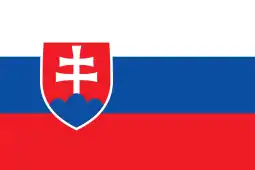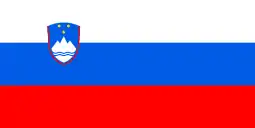Hranice (Přerov District)
Hranice (Czech pronunciation: [ˈɦraɲɪtsɛ]; German: Weißkirchen or Mährisch Weißkirchen) is a town in the Přerov District in the Olomouc Region of the Czech Republic. It has about 18,000 inhabitants. The historic town centre is well preserved and is protected by law as an urban monument zone. The town is known for the Hranice Abyss.
Hranice | |
|---|---|
 Masarykovo Square with the old town hall | |
.svg.png.webp) Flag  Coat of arms | |
 Hranice Location in the Czech Republic | |
| Coordinates: 49°33′9″N 17°46′6″E | |
| Country | |
| Region | Olomouc |
| District | Přerov |
| Founded | 12th century |
| Government | |
| • Mayor | Jiří Kudláček |
| Area | |
| • Total | 49.78 km2 (19.22 sq mi) |
| Elevation | 250 m (820 ft) |
| Population (2021-01-01)[1] | |
| • Total | 17,818 |
| • Density | 360/km2 (930/sq mi) |
| Time zone | UTC+1 (CET) |
| • Summer (DST) | UTC+2 (CEST) |
| Postal codes | 753 01, 753 54, 753 61 |
| Website | www |
Administrative parts
Villages of Drahotuše, Lhotka, Rybáře, Slavíč, Středolesí, Uhřínov, Valšovice and Velká are administrative parts of Hranice. Středolesí and Uhřínov form an exclave of the municipal territory.
Etymology
The name Hranice literally means "border". It is sometimes called Hranice na Moravě ("Hranice in Moravia") to distinguish from other places with the same name.
Geography
The deepest pit cave in the Czech Republic (473.5 metres (1,553 ft)), Hranice Abyss, is located by the town. With a water depth of 404 metres (1,325 ft), it is also the deepest flooded abyss in the world.[2]
The Bečva River flows through the municipal territory.
History

The first written mention of Hranice is in a falsificated document from 1169, according to the trusted sources Hranice already existed at the end of the 12th century. In 1276, Hranice became a town. From 1420s, the town became a property of Cimburk family, and from 1499 a property of Pernštejn family. In 16th and 17th centuries, the manor often changed owners.[3]
Until 1918, Hranice was part of the Austrian monarchy (Austria side after the compromise of 1867), in the district with the same name, one of the 34 Bezirkshauptmannschaften in Moravia.[4] The German name only was used before 1867 (including Weiskirchen).[5]
In the days of Austria-Hungary,[6] in the interbellum Czechoslovakia,[7] and during the communist era[8] the city hosted a large military academy. Notable graduates include Archduke Wilhelm of Austria and Herman Potočnik.[6]
Jewish population

The first Jews came in 1611,[3] receiving in 1637 the right for a self-governed Jewish quarter, around the present Janáčkova street (renamed from Židovská street). Besides those 17 houses, they were not allowed to purchase houses elsewhere. The community reached a high 802 people in 1857 (13% of the entire town).[9] They had a significant role in the development of Hranice's industry: a textile plant established in 1844 (the largest factory until the mid-20th century), and distilleries (1827, 1836).[10]
Demography
|
|
| ||||||||||||||||||||||||||||||||||||||||||||||||||||||
| Source: Historical lexicon of municipalities of the Czech Republic[11] | ||||||||||||||||||||||||||||||||||||||||||||||||||||||||
Economy

In 1883, Antonín Kunz founded a company in Hranice that specialized in the production of windpumps and other pumps. The company became the largest factory for water pumps in Austria-Hungary. At the end of the 19th century, it also produced complete communal water systems that were in towns and cities in the whole Austria-Hungary. The Sigma Pumps company that developed out of Kunz's company.[12]
The largest employer in the town is SSI Schäfer.
Transport
Hranice lies on the railway from Přerov to Vsetín. The town is served by train stations Hranice na Moravě, Hranice na Moravě město, and Drahotuše. In the municipal territory is also located the Teplice nad Bečvou station, which serves this neighbouring municipality.
Sights


Since 1992, the historic town centre is protected as an urban monument zone.[3] The church of the Beheading of Saint John the Baptist is the landmark of the town square. The construction was finished in 1763. It is a massive Baroque-Neoclassical building with valuable decorations of the interior. The second significant building on the square is the old town hall. It served its purpose until 1998, when the offices moved to the premises of the castle. Today it serves as a library, a museum, and a concert hall.[13]
The Hranice Castle was formerly a Gothic castle of Cimburk lords. In 16th–17th centuries it was rebuilt in the Renaissance style.[3] Today it serves as the town hall, museum and gallery.[13][14]
The Jewish community is commemorated by several monuments. The original small synagogue was replaced in 1863 by new larger building in Moorish-Byzantine style. It is used for cultural purposes.[10] The Jewish cemetery was used until 1965. The oldest preserved tombstone is from 1685.[15]
The most valuable technical monument are the Hranice Viaducts. The three viaducts are 430 metres (1,410 ft) long. The oldest one is from 1844–1846.[13]
Notable people
- Daniel Strejc-Vetterus (1592–1669), priest of the Unity of the Brethren
- Aaron Chorin (1766–1844), Hungarian rabbi
- Baruch Placzek (1834–1922), rabbi and author
- Isidore Singer (1859–1939), author and editor
- Franz Petrak (1886–1973), Austrian-Czech mycologist
- Albert Kutal (1904–1976), historian
- Helmut Otto Hofer (1912–1989), Austrian anatomist and zoologist
- Jiří Brdečka (1917–1982), writer
- Dalibor Janda (born 1962), singer
Twin towns – sister cities
 Hlohovec, Slovakia
Hlohovec, Slovakia Konstancin-Jeziorna, Poland
Konstancin-Jeziorna, Poland Leidschendam-Voorburg, Netherlands
Leidschendam-Voorburg, Netherlands Slovenske Konjice, Slovenia
Slovenske Konjice, Slovenia
See also
- The Confusions of Young Törless, a novel based on experience in the Hranice military academy
References
- "Population of Municipalities – 1 January 2021". Czech Statistical Office. 2021-04-30.
- "Hranická propast" (in Czech). Město Hranice. Retrieved 2021-05-31.
- "Historie města" (in Czech). Město Hranice. Retrieved 2021-05-31.
- Die postalischen Abstempelungen auf den österreichischen Postwertzeichen-Ausgaben 1867, 1883 und 1890, Wilhelm Klein, 1967
- Handbook of Austria and Lombardy-Venetia Cancellations on the Postage Stamp Issues 1850–1864, by Edwin Mueller, 1961.
- Snyder, Timothy (28 September 2010). The Red Prince: The Secret Lives of a Habsburg Archduke. Basic Books, 2010. ISBN 978-0465018970. Retrieved 7 November 2013.
- White, Lewis M. (1991). On all fronts: Czechs and Slovaks in World War II. East European Monographs, 2000. ISBN 9780880334563. Retrieved 7 November 2013.
- Gadourek, Ivan. "The Political Control of Czechoslovakia: Study in Social Control of a Soviet Satellite State", Kroese, 1953, p.72
- Za krásami městské památkové zóny Hranice, texts published below the synagogue
- "Synagoga" (in Czech). Tourist Information Centre Hranice. Retrieved 2021-11-10.
- "Historický lexikon obcí České republiky 1869–2011 – Okres Přerov" (in Czech). Czech Statistical Office. 2015-12-21. pp. 3–4.
- "Company". Sigma Pumpy Hranice, Ltd. Retrieved 2021-11-10.
- "Památky" (in Czech). Tourist Information Centre Hranice. Retrieved 2021-11-10.
- "Zámek" (in Czech). Muzeum Hranice. Retrieved 2021-05-31.
- "Židovský hřbitov" (in Czech). Tourist Information Centre Hranice. Retrieved 2021-11-10.
- "Partnerská města" (in Czech). Město Hranice. Retrieved 2020-08-29.
External links
| Wikimedia Commons has media related to Hranice (Přerov District). |
- Official website (in Czech)